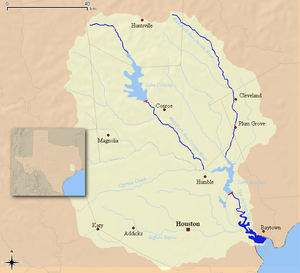San Jacinto River (Texas) facts for kids
The San Jacinto River (pronounced SAN juh-SIN-toh) is an important river in Texas. It flows from Lake Houston in Harris County, Texas, all the way to Galveston Bay. Long ago, Native American tribes like the Karankawa and Akokisa lived along its banks. The river gets its name from Saint Hyacinth.
Contents
The River's Journey
The San Jacinto River has two main parts, called forks. These are the East Fork and the West Fork.
West Fork
The West Fork of the San Jacinto River starts its journey by feeding Lake Conroe. From there, it flows south through Montgomery County.
East Fork
The East Fork begins in Walker County, north of the Sam Houston National Forest. Smaller streams that feed both forks start near Lake Livingston. This is a large reservoir on the Trinity River. The East Fork flows south through Cleveland in Liberty County, and Montgomery County.
Meeting Point
Both the East and West Forks meet in northeast Harris County. Here, they form Lake Houston. As the river continues south, it joins with Buffalo Bayou. Finally, the San Jacinto River empties into Galveston Bay.
History of the San Jacinto River
The San Jacinto River has played a big part in Texas history.
The Battle of San Jacinto
A very important event happened near the river in 1836. This was the Battle of San Jacinto. It took place during the Texas Revolution. The Texas army won a major victory here. This win led to the creation of the Republic of Texas. Today, you can visit the San Jacinto Battleground State Historic Site. This park is also home to the tall San Jacinto Monument.
Protecting the River
Over the years, people have worked to keep the San Jacinto River clean and safe.
Past River Incidents
In October 1994, heavy floods caused problems along the river. Several pipelines carrying oil products broke. The escaping products caught fire. This caused injuries to many people.
Cleaning Up Waste Pits
In 2008, the U.S. Environmental Protection Agency (EPA) added the San Jacinto River waste pits to a special cleanup list. This list is called the federal Superfund program. Superfund sites are places with dangerous pollution that need to be cleaned up.
In 2017, Hurricane Harvey brought a lot of flooding. This flood damaged a protective wall at the San Jacinto River Waste Pits site. This caused harmful chemicals called dioxins to get into the river. The EPA ordered two companies, International Paper and McGinnis Industrial Maintenance Corp, to pay $115 million. This money is used to clean up the polluted area and protect the river.
See also
 In Spanish: Río San Jacinto para niños
In Spanish: Río San Jacinto para niños



